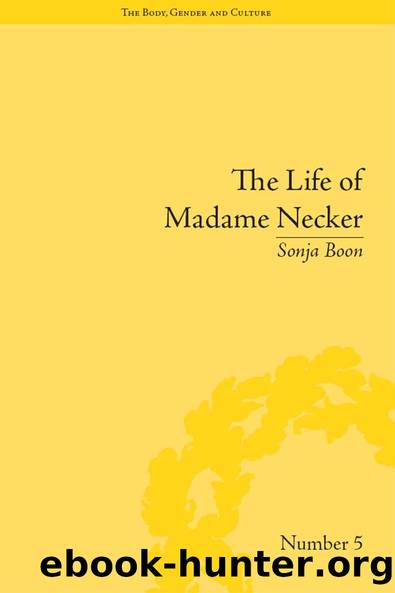The Life of Madame Necker by Sonja Boon

Author:Sonja Boon [Boon, Sonja]
Language: eng
Format: epub
Tags: History, General, Europe, France
ISBN: 9781317323679
Google: Y-05CgAAQBAJ
Publisher: Routledge
Published: 2015-10-06T16:11:09+00:00
Pathologizing Women: Vitalism, Illness and Gender
On 6 April 1773, Suzanne Necker remarked to a friend: âI am losing track of my time and my health; my sensibility alone is unlimitedâ.64 In this statement Necker acknowledged not only the frantic pace required by her public roles as salonnière and political wife, but also the deep relationships between illness, sensibility and female experience. For Madame Necker, illness functioned as a channel for her sensibility, a way to engage with the most personal aspects of her being and, from there, to engage more fully and more deeply with the physical and moral sufferings of others. Illness was, finally, a vehicle through which she could express the full extent of her psychic distress and feelings of filial culpability. Madame Necker defined cultural, religious and filial alterity through malady. In so doing, she demonstrated that the interplay between psychic and somatic markers of illness functioned as an integral aspect of her conception of self.
Madame Neckerâs experiences were directly informed by the emergence of medical vitalism. A medical movement which appears to have originated sometime around the middle of the century, vitalism moved away from anatomical and humoral understandings of the body by positing the body as a vital entity â living, moving and dynamic. This body was created of multiple parts, all intimately linked together through the property of sensibility.65 The vitalist perspective fundamentally transformed medical and moral understandings of the body. By positing an interconnected psychic and corporeal system, vitalists theorized sensibility as an active agent and argued for a holistic understanding of the individual. In contrast to the work of anatomists, which relied on static understandings of the body, vitalist philosophy posited a dynamic body that was continually in process and organized through a series of constantly mobile inter-relationships. Physical and mental disease were intrinsically connected, the vitalists argued, the health of one dependent wholly upon the health and fitness of the other.
Vitalist médecins philosophes understood the body as an entity constructed of multiple individual parts, impulses and ideas, each of which was intimately linked to the other by a sensitive and nuanced nervous system. Integral to vitalist thought was the desire to bridge the gap between the Cartesian mind and body, a move beyond the purely mechanist understanding of the body as a system apart from the mind. In the vitalist framework, the mind acted upon the body as much as the body acted upon the mind, thus laying the groundwork for psychic trauma to become manifest in the form of physical distress.
The inter-relationships central to the vitalist model were made possible by the idea of sensibility, which was seen as a mediating or bridging dynamic facilitating the interaction between psyche and soma. As Elizabeth A. Williams suggests, vitalists âluxuriated in the passional origins of disease, which functioned as the most persuasive proof available of the soulâs direct action on the bodyâ.66 While such a fluid interplay was generally perceived as beneficent, it was equally perceived as threatening: left unchecked, sensibility metamorphosed into dangerous instability.
Download
This site does not store any files on its server. We only index and link to content provided by other sites. Please contact the content providers to delete copyright contents if any and email us, we'll remove relevant links or contents immediately.
The European History Highway: A Guide to Internet Resources by Dennis A. Trinkle Scott A. Merriman(495)
The Seven Wonders of the Ancient World by Michael Denis Higgins(478)
European Security in a Global Context by Thierry Tardy(471)
European Security without the Soviet Union by Stuart Croft Phil Williams(469)
The Routledge companion to Christian ethics by D. Stephen Long Rebekah L. Miles(458)
Hudud Al-'Alam 'The Regions of the World' - a Persian Geography 372 A.H. (982 AD) by V. V. Minorsky & C. E. Bosworth(399)
Gorbachev And His Generals by William C. Green(391)
Get Real with Storytime by Julie Dietzel-Glair & Marianne Crandall Follis(390)
Tibetan Studies in Comparative Perspective by Chih-yu Shih Yu-Wen Chen(385)
Governance, Growth and Global Leadership by Espen Moe(381)
Hyperculture by Byung-Chul Han(378)
CliffsNotes on Fitzgerald's The Great Gatsby by Kate Maurer(360)
The Oxford History of the World by Fernández-Armesto Felipe;(354)
How Languages Are Learned 5th Edition by Patsy M Lightbown;Nina Spada; & Nina Spada(353)
The Egyptian Economy, 1952-2000 by Khalid Ikram(352)
Oral Poetry and Narratives from Central Arabia: The Poetry of Ad-Dindan : A Bedouin Bard in Southern Najd (Studies in Arabic Literature, Vol 17) (English and Arabic Edition) by P. M. Kupershoek P. Marcel Kurpershoek(345)
The Oxford Handbook of the Incas by Sonia Alconini(333)
Europe Contested by Harold James(320)
The Hutchinson Dictionary of Ancient and Medieval Warfare by Peter Connolly John Gillingham John Lazenby(305)
